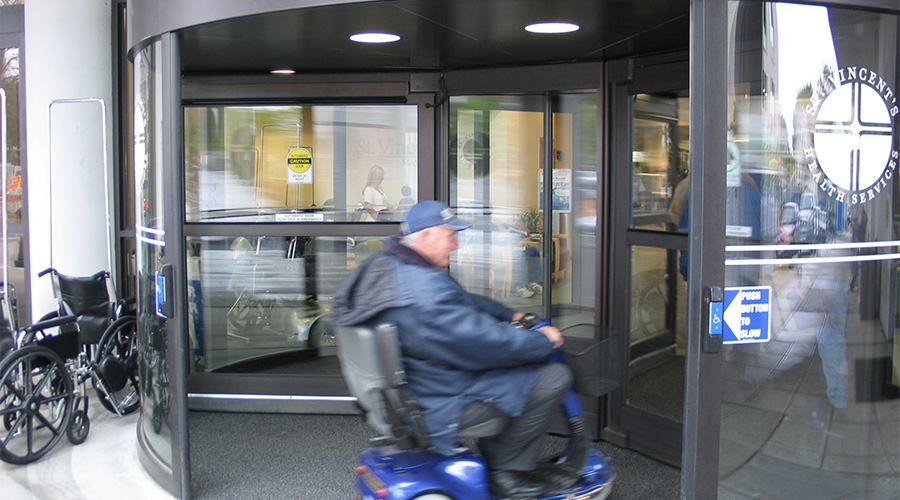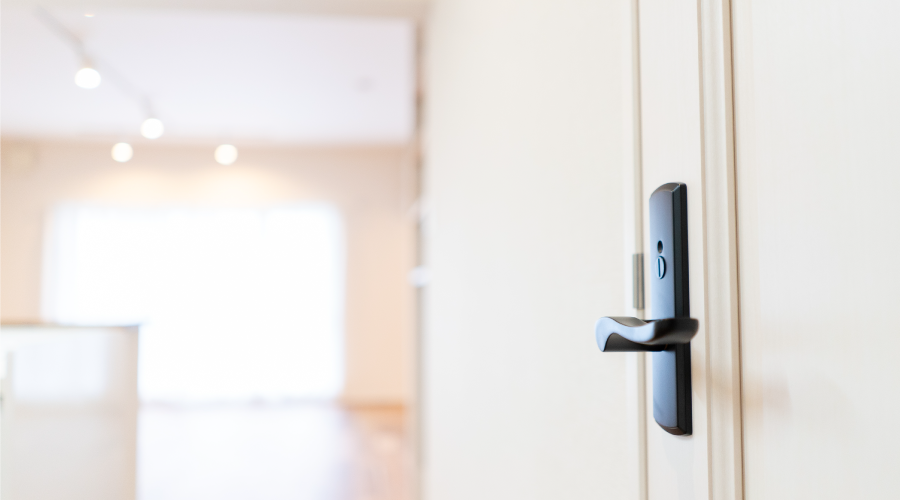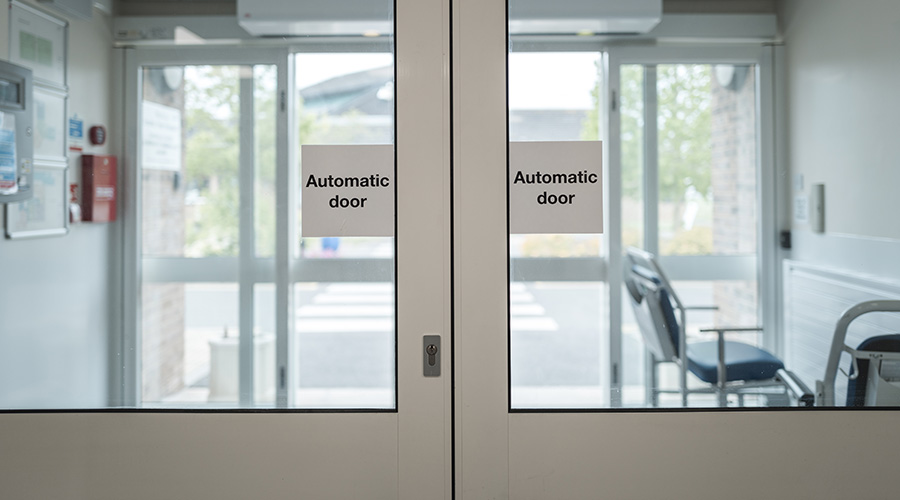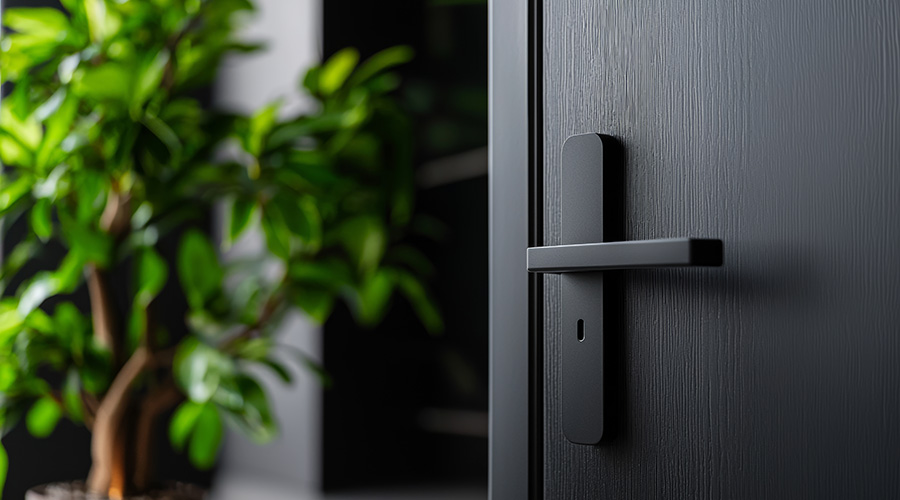The Ins and Outs of Security
Strategic specification of key door-hardware components begins with understanding current product options
Facility security needs certainly aren’t what they once were. Then again, neither are the products managers can specify to keep facilities, operations and occupants safe. As security needs have evolved in recent years in response to tragic events and changing priorities, manufacturers of door-hardware components have retooled existing products and introduced new ones.
By reviewing key changes in these components — including locks, handles, hinges and operators – managers can more effectively specify the most appropriate components to meet their organizations’ security needs.
Evolving Products
Two of the most important considerations for specifying appropriate door-hardware components are dimensions and frequency of use.
When evaluating whether to upgrade or replace any components, managers must consider the door’s size and weight to ensure proper application. Cycling frequency is another important factor, since busier locations, such as entrances and main areas, get much greater wear and tear than remote offices or closets. The heavier the door and the more frequent the use, the more robust components must be.
Manufacturers divide door hardware into classes based on frequency of use. Class 1 products can withstand the highest frequency of use and Class 3, the lowest. Class 1 hardware will be heavier gage and, if a door is large, bigger to accommodate the extra weight and longer lever arm it must support.
Managers also need to weigh aesthetic factors, such as finish and shape. Many new finishes are available, and components can be painted or plated. Painted components usually match the wall and trim, while plated components match the other hardware to provide a uniform appearance. Shape features are specific to the component. For example, hinges might be specified with: square or radius corners; three, four, or five knuckles; and bushing or bearing designs.
LOCKS. When comparing new locks or lock-upgrade options, specifiers should look for security consistent with easy access and egress. Manufacturers now offer a growing list of both keyed and keyless locks to fit every need.
New high-security locks and keyless locks are designed to improve security. A typical keyless lock combines a spring lock, dead bolt, keypad and knob or handle in one unit. Some keyless-lock models contain no wiring and no batteries, and authorized individuals can open them with an assigned code. Managers also can specify an optional master key lock to allow staff to enter without a code.
HANDLES. A growing list of finishes for handles and knobs are available to match any architectural style. Polished brass had been specified 70 percent of the time, but black, brown, bronze, stainless and chrome, both polished and brushed or matte finish, also are available. Today, the trend is toward nickel-based finishes with stainless steel as the standard in hospitals, schools, and commercial facilities.
Silver ion technology offers an antimicrobial surface solution. Handles, knobs, push plates and push bars are coated with an antimicrobial silver ion solution. The solution’s slow-release property allows it to interact to reduce bacteria, fungi, mold, and yeast, and it is active for the life of the handle. Antimicrobial coatings are not limited to hospital applications and might be a smart choice for schools, research labs, and commercial facilities.
HINGES. Manufacturers offer an expanding array of manual and electric hinges. Styles include full mortise — inset flush with the surface — full surface, half mortise, and half surface, as well as an assortment of continuous geared, spring and pivot, and single- and double-acting hinges.
Double-acting horizontal spring hinges are popular in hospitals, having a 90-degree hold-open feature and a plated or painted finish. This type of hinge inserts into the door bottom via a rectangular mortise and attaches to the floor with screws through a floor plate with slotted holes for easier and quicker alignment.
Electric hinges are wired to allow constant current flow to activate electric locks and exit devices regardless of door position. A magnetic monitor mounted behind the hinge actuated by a reed switch enables linking with the access-control system and provides continuous, remote tracking of the door’s status.
OPERATORS. Door operators can be manual or automatic, low- or high-energy, sliding, swinging, revolving, overhead vertical, or overhead roll-up. They also feature both horizontal and vertical sliding and swinging gates.
Applications for low-energy swinging-door operators include hotel rooms, VIP offices, accessible areas, and educational living areas. High-energy applications include airport entrances, department stores, large office buildings, and hospital emergency and operating rooms.
Typically, low-energy operators use an AC motor and hydraulic pump to activate a heavy-duty closer. An electronic-limit-switch circuit board controls the swing-arc length.
Some characteristics to consider are:
• units that are field reversible or fixed right or left handed
• push or pull side mounting
• power-operator function configuration
• integration with electric hardware and access control systems
• fire rating
• optional manual operation
• startup options, such as wall switch, radio-frequency device, or push and go
• hold-open choices, such as 0-30 seconds, and 5 seconds minimum for accessibility compliance
• obstruction detection and action, meaning the door opens if it hits an object during closing and closes if it hits object during opening.
Today, architects and engineers specify both manual and automatic revolving doors for new or upgrade applications because of their improved elimination of drafts and pollution, energy efficiency, low maintenance, and durability.
Automatic security revolving doors typically are powered by adjustable low-speed operators. When they receive a card signal through a control panel, gearbox, and high-torque electric motor, the operator moves the door in the lower energy and speed mode. A user can move the door faster by pushing it without interfering with the power operator.
General considerations for automatic door operators include:
• wireless, remote, door-speed setup and adjustment
• hands-free operation
• voice-prompt adjustable speed for easier access to accommodate wheelchairs or large objects
• motion sensors that start operation on the user’s approach
• access-control features for greater security.
Matching Products and Needs
The best way to ensure components meet safety and security needs is to know they meet industry standards for the particular application. As a further aid to the specifier,
ANSI/
BHMA now have 31 comprehensive standards for door-hardware components under the general designation A156.
Each standard describes device characteristics and testing procedures to ensure products in a certain class meet the requirements of that class for safety, security and durability. Architects and engineers should specify that door hardware components meet this standard to ensure the installation meets a known level of quality.
More managers are considering an upgrade of keyed locks to keyless installations because keyed locks have been subject to tampering. For example, simple bump keys and pick sets have opened many existing keyed locks quickly. They have been made out of key blanks and hacksaw blades in a few minutes using ordinary hand tools and a bench grinder.
An intruder using a bump key can insert the specially ground key blank into the lock, back it out one ridge, apply side pressure, and bump the end of the key to open the lock in a few seconds. For this reason, manufacturers have introduced digital-keypad locks, magnetic-card locks, and biometric identification combined with card locks. Also,
ANSI/
BHMA has released standard A156.30 for high-security lock cylinders.
Newer automatic-security revolving doors can be card- or key-locked and integrated with all security and safety systems, such as access control and building management systems. Their safety and security features include idling when obstructed, torque limiting, cushioning, controlled access, integrated metal detectors, metal-detector alarms, bullet resistance, and weight checkers to determine if an object remains in the door space.
Managers can program them for two-way access control, as well as day or night operation. Day operation allows for free in-and-out access, and night operation reverts to in-and-out access control and integration with the access-control system through a microprocessor.
An additional security feature activates if an authorized user and an unauthorized user try to pass in opposite directions. If the authorized user approaches the access-control door at the same time as the unauthorized user attempts to enter from the opposite side, an electric brake locks the door, an access-refusal and door-reversal warning sounds, the door reverses to allow clearance of the secure area, and the door returns to normal operation.
Depending on options selected, these doors can provide a valuable assist to security personnel, while at the same time yielding a high return on investment.
Related Topics:











